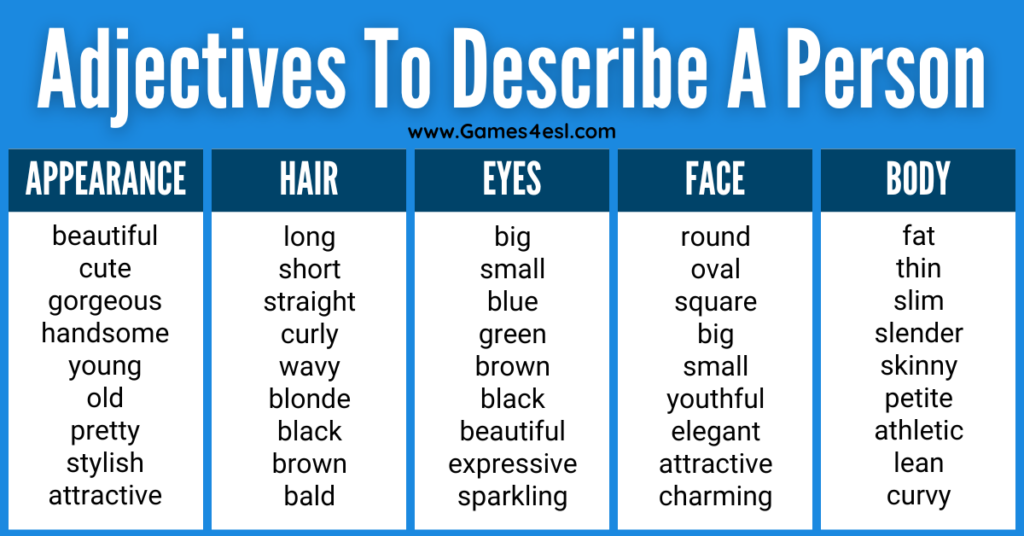Now Reading: Adjectives to Describe a Person: A Comprehensive Guide
-
01
Adjectives to Describe a Person: A Comprehensive Guide
Adjectives to Describe a Person: A Comprehensive Guide

Finding the right words can be tough, but when it comes to people, the perfect adjective can make all the difference. Whether you’re writing a story, giving a compliment, or just trying to understand someone better, having a rich vocabulary is key. This guide is your ultimate resource for exploring the vast world of adjectives to describe a person. We will break down different categories of words, from personality and appearance to emotions and character traits. You’ll learn how to use these words effectively and add more color and precision to your language.
Think of this as your toolbox for painting a complete picture of an individual. We’ll cover positive, negative, and neutral terms, helping you to express yourself clearly and accurately. By the end, you’ll have a powerful list of words at your fingertips.
Key Takeaways
- Variety is Key: There are thousands of adjectives to describe a person, covering everything from their personality and appearance to their emotional state and intellectual abilities.
- Context Matters: The right adjective depends on the situation. A word that is a compliment in one context might be an insult in another.
- Positive and Negative Traits: Understanding the difference between positive (e.g., kind, generous) and negative (e.g., rude, selfish) adjectives helps in accurately portraying a person’s character.
- Beyond the Basics: Moving beyond simple words like “nice” or “bad” allows for more nuanced and descriptive character portrayals.
- Practical Application: These adjectives are useful in creative writing, daily conversation, professional feedback, and personal development.
Understanding What Adjectives Are
Before we dive into the lists, let’s quickly review what an adjective is. An adjective is a word that describes or modifies a noun or a pronoun. In our case, the noun is a “person.” So, when we use adjectives to describe a person, we are adding detail and giving more information about them. For example, instead of just saying, “She is a person,” you could say, “She is a creative and enthusiastic person.” See how those two words immediately create a more vivid image? Adjectives answer questions like: What kind? How many? Which one? They are the descriptive words that bring our sentences to life. Using a wide range of them can significantly improve your communication skills, making your writing and speech more engaging and precise.
Positive Adjectives for Personality Traits
When you want to highlight someone’s good qualities, positive adjectives are the way to go. These words can be used to give compliments, write a recommendation, or create a likable character in a story. They focus on the strengths and virtues that make a person pleasant to be around. Using these adjectives to describe a person can lift spirits and build positive relationships. Think about the people you admire most; words like honest, brave, and compassionate likely come to mind. These terms go beyond surface-level observations and speak to the core of someone’s character. Choosing the right positive adjective shows that you have paid attention to someone’s best qualities and appreciate them.
Examples of Positive Personality Adjectives
- Affectionate: Showing fondness or tenderness.
- Ambitious: Having a strong desire and determination to succeed.
- Brave: Ready to face and endure danger or pain; showing courage.
- Charismatic: Exercising a compelling charm that inspires devotion in others.
- Compassionate: Feeling or showing sympathy and concern for others.
- Conscientious: Wishing to do one’s work or duty well and thoroughly.
- Courageous: Not deterred by danger or pain.
- Creative: Having the ability to create or invent things.
- Diligent: Showing care and conscientiousness in one’s work or duties.
- Empathetic: Able to understand and share the feelings of another.
- Enthusiastic: Having or showing intense and eager enjoyment.
- Generous: Showing a readiness to give more of something, like money or time, than is strictly necessary.
- Gregarious: Fond of company; sociable.
- Honest: Free of deceit and untruthfulness; sincere.
- Humble: Having or showing a modest or low estimate of one’s own importance.
- Innovative: Featuring new methods; advanced and original.
- Kind: Having or showing a friendly, generous, and considerate nature.
- Loyal: Giving or showing firm and constant support to a person.
- Optimistic: Hopeful and confident about the future.
- Passionate: Showing or caused by strong feelings or beliefs.
- Persistent: Continuing firmly in a course of action in spite of difficulty.
- Resourceful: Having the ability to find quick and clever ways to overcome difficulties.
- Sincere: Free from pretense or deceit; proceeding from genuine feelings.
- Tolerant: Willing to accept behavior and beliefs that are different from your own.
- Witty: Showing or characterized by quick and inventive verbal humor.
Negative Adjectives for Personality Traits
While it’s not always pleasant, sometimes we need to describe the less desirable qualities of a person. Negative adjectives help us articulate flaws, weaknesses, or harmful behaviors. These words can be used to create a villain in a story, provide constructive criticism, or simply express frustration with someone’s actions. It’s important to use these words carefully and thoughtfully, as they can be hurtful. When using negative adjectives to describe a person, be sure you are being fair and accurate in your assessment. Words like arrogant, lazy, or dishonest carry significant weight. Using them correctly is crucial for clear and honest communication, even when the subject is difficult.
Examples of Negative Personality Adjectives
- Abrasive: Showing little concern for the feelings of others; harsh.
- Arrogant: Having an exaggerated sense of one’s own importance or abilities.
- Callous: Showing or having an insensitive and cruel disregard for others.
- Deceitful: Guilty of or involving deceit; deceiving or misleading others.
- Dishonest: Behaving or prone to behave in an untrustworthy or fraudulent way.
- Domineering: Asserting one’s will over another in an arrogant way.
- Fickle: Changing frequently, especially as regards one’s loyalties or affections.
- Gullible: Easily persuaded to believe something; credulous.
- Hostile: Unfriendly; antagonistic.
- Impulsive: Acting or done without forethought.
- Inconsiderate: Thoughtlessly causing hurt or inconvenience to others.
- Lazy: Unwilling to work or use energy.
- Malicious: Characterized by malice; intending or intended to do harm.
- Moody: Given to unpredictable changes of mood.
- Naive: Showing a lack of experience, wisdom, or judgment.
- Obnoxious: Extremely unpleasant.
- Pessimistic: Tending to see the worst aspect of things or believe that the worst will happen.
- Rude: Offensively impolite or ill-mannered.
- Selfish: Lacking consideration for others; concerned chiefly with one’s own personal profit or pleasure.
- Stingy: Unwilling to give or spend; ungenerous.
- Stubborn: Having or showing dogged determination not to change one’s attitude or position on something.
- Vain: Having or showing an excessively high opinion of one’s appearance, abilities, or worth.
Adjectives for Physical Appearance
Describing how someone looks is a common use of adjectives. These words help us paint a picture with our language, allowing others to visualize the person we’re talking about. Physical appearance adjectives can cover everything from height and build to hair color and facial features. Using specific and varied adjectives to describe a person‘s appearance makes descriptions more vivid and memorable. For writers, this is especially important for bringing characters to life. Instead of saying someone is “tall,” you might say they are lanky or towering. Instead of “pretty,” you could use radiant or charming. These choices add depth and personality to your descriptions.
|
Category |
Example Adjectives |
|---|---|
|
Height |
Towering, Short, Lanky, Petite, Statuesque, Compact |
|
Build |
Slender, Stocky, Muscular, Plump, Wiry, Robust |
|
Hair |
Curly, Straight, Wavy, Silky, Coarse, Unruly, Balding |
|
Face |
Round, Oval, Square, Angular, Freckled, Wrinkled |
|
Eyes |
Sparkling, Piercing, Expressive, Deep-set, Bright, Weary |
|
General |
Elegant, Scruffy, Dapper, Graceful, Gangly, Polished |
Describing Style and Fashion
A person’s clothing and style also say a lot about them. You can use adjectives to describe their fashion sense, which often reflects their personality.
- Chic: Elegantly and stylishly fashionable.
- Dapper: Neat and trim in dress and appearance (typically used for men).
- Dowdy: Unfashionable and without style in appearance (typically used for women).
- Eclectic: Deriving ideas, style, or taste from a broad and diverse range of sources.
- Elegant: Graceful and stylish in appearance or manner.
- Preppy: Relating to a style of dress characterized by classic, clean-cut, and often expensive clothing.
- Sloppy: Careless and unsystematic; excessively casual.
- Trendy: Very fashionable or up to date.
Adjectives to Describe Emotions and Moods
People are emotional beings, and their feelings can change from one moment to the next. Adjectives that describe emotions and moods are essential for conveying a person’s inner state. Are they feeling joyful after receiving good news? Or are they anxious about an upcoming exam? These words help us express empathy and understand what someone is going through. Using the right emotional adjectives to describe a person allows for a deeper connection and more meaningful communication. A character in a story becomes much more relatable when we know if they are content, melancholy, or agitated. This category of adjectives is fundamental to expressing the human experience.
Common Adjectives for Emotions
- Anxious: Experiencing worry, unease, or nervousness.
- Blissful: Extremely happy; full of joy.
- Content: In a state of peaceful happiness.
- Crestfallen: Sad and disappointed.
- Ecstatic: Feeling or expressing overwhelming happiness or joyful excitement.
- Exuberant: Filled with or characterized by a lively energy and excitement.
- Frustrated: Feeling or expressing distress and annoyance, especially because of inability to change or achieve something.
- Grateful: Feeling or showing an appreciation of kindness; thankful.
- Hopeful: Feeling or inspiring optimism about a future event.
- Inquisitive: Curious or inquiring.
- Jubilant: Feeling or expressing great happiness and triumph.
- Melancholy: A feeling of pensive sadness, typically with no obvious cause.
- Nostalgic: Feeling a sentimental longing for the past.
- Serene: Calm, peaceful, and untroubled.
- Somber: Dark or dull in color or tone; gloomy.
- Wistful: Having or showing a feeling of vague or regretful longing.
Neutral Adjectives to Describe a Person
Not all adjectives are strictly positive or negative. Many words are neutral, meaning they simply state a fact or observation without passing judgment. These neutral adjectives to describe a person are incredibly useful for objective descriptions. For instance, stating that someone is introverted isn’t a criticism; it’s a description of their social preferences. Similarly, calling someone tall or young is just stating a physical characteristic. Neutral adjectives are the foundation of factual reporting and unbiased observation. They are often used in professional contexts, like those discussed on platforms such as ForbesPlanet, where clear and unbiased information is valued. Using these words helps to avoid misunderstandings and ensures your descriptions are fair.
Here are some examples of neutral adjectives:
- Analytical: Relating to or using analysis or logical reasoning.
- Assertive: Having or showing a confident and forceful personality.
- Cautious: Careful to avoid potential problems or dangers.
- Formal: Done in accordance with rules of convention or etiquette.
- Introverted: A person predominantly concerned with their own thoughts and feelings rather than with external things.
- Extroverted: An outgoing, overtly expressive person.
- Methodical: Orderly or systematic in thought or behavior.
- Pensive: Engaged in, involving, or reflecting deep or serious thought.
- Quiet: Making little or no noise.
- Reserved: Slow to reveal emotion or opinions.
- Serious: Demanding or characterized by careful consideration or application.
- Spontaneous: Performing or occurring as a result of a sudden inner impulse.
- Subjective: Based on or influenced by personal feelings, tastes, or opinions.
- Talkative: Fond of or given to talking.
- Traditional: Adhering to long-established customs.
- Youthful: Young or seeming young.
Putting It All Together: Creating a Character Sketch
Now that you have a wide array of adjectives, let’s practice using them to build a character sketch. The key is to choose words from different categories to create a well-rounded and believable portrait. A good description uses a mix of adjectives to describe a person, covering their personality, appearance, and emotional state.
Let’s create a character named Alex.
- Appearance: Alex is a lanky teenager with a mop of unruly brown hair that often falls over his expressive green eyes. He has a boyish face with a smattering of freckles across his nose. His style is eclectic and a bit scruffy—usually a mix of vintage band t-shirts and worn-out jeans.
- Personality: On the surface, Alex seems reserved and pensive, often lost in thought. However, among his close friends, he is known for being incredibly witty and loyal. He is conscientious about his schoolwork but not overly ambitious, preferring to spend his time on his creative pursuits like drawing and writing music. He can sometimes be moody and stubborn when he feels misunderstood.
- Emotional State: Lately, Alex has been feeling anxious about his future after high school but remains hopeful that his art will lead him somewhere interesting. He is deeply empathetic and often feels the weight of his friends’ problems.
By combining these different types of adjectives, we get a much clearer and more interesting picture of Alex than if we had just said he was a “nice kid.”
Conclusion
Mastering the use of adjectives to describe a person is a powerful skill that enhances your ability to communicate. From crafting compelling characters in a story to giving a heartfelt compliment, the right words can convey nuance, depth, and emotion. We have explored positive, negative, and neutral adjectives that cover personality, appearance, and feelings. By expanding your vocabulary with these words, you can paint vivid pictures in the minds of your readers and listeners. Remember that context is crucial, and the best descriptions often come from a thoughtful combination of different types of adjectives. Keep this guide as a reference, and continue to observe the people around you. You’ll find that the world is full of fascinating individuals, each deserving of a description as unique as they are.
Frequently Asked Questions (FAQ)
Q1: What is the purpose of using different types of adjectives to describe a person?
Using a variety of adjectives—positive, negative, and neutral—helps create a well-rounded and realistic description. It allows you to cover personality, appearance, and emotions, providing a much more detailed and nuanced picture of an individual than if you only used simple, one-dimensional terms.
Q2: How can I avoid being offensive when using negative adjectives?
Context is key. Use negative adjectives when you need to be honest for a specific purpose, such as providing constructive feedback or describing a fictional antagonist. Avoid using them as insults or in a malicious way. Ensure your description is fair and based on observable behaviors rather than prejudiced judgments.
Q3: Can an adjective be both positive and negative?
Yes, some adjectives can be interpreted differently depending on the context. For example, ambitious can be a positive trait, suggesting drive and determination. However, if someone is overly ambitious, it could imply a negative quality of being ruthless. Similarly, childish can mean playful and fun, or it can mean immature.
Q4: Where can I find more lists of adjectives to describe a person?
Thesauruses are excellent resources for finding synonyms and expanding your vocabulary. Reading widely also exposes you to new descriptive words in context. Websites dedicated to writing and language, as well as educational resources like https://forbesplanet.co.uk/, often provide valuable articles and lists for writers and learners.
Q5: How many adjectives are too many when describing someone?
There’s no hard rule, but it’s best to be selective. Overloading a description with too many adjectives can make it confusing and cluttered. Choose a few powerful and precise words that best capture the person’s essence rather than listing every possible trait. A good character sketch focuses on the most defining qualities.

















